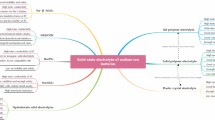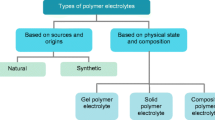Abstract
A new polyaspartimide was synthesized via a Michael addition reaction of an aromatic bismaleimide (BMI) with aminoethylpiperazine (AEP) at 1:1 molar ratio. IR and NMR spectral techniques were used for the characterization of the newly synthesized polyaspartimide (PAI). The copolymer, piperazine containing polyaspartimide, was then blended with polysulfone (Psf) at 3 and 6 wt % by dissolving in the solvent DMF. The blend membranes are studied for their water uptake, ion exchange capacity, swelling ratio, chemical stability, morphology, and proton conductivity. It is observed from morphological studies that the porous structure of polysulfone has been retained even after the incorporation of PAI. The percentage water uptake of membranes of different compositions reveals that the blending of copolymer PAI with polysulfone enhances the water uptake nature of the membrane. The chemical stability on membranes revealed that Psf/PAI-6% has a degradation of about 2.26% which is much lower than that of neat Psf membranes (3.43%), higher chemical stability. The neat Psf found to have an IEC value of 8.045 mmol/g and the IEC values increase with the addition of PAI. The highest value of IEC is obtained for the 6% PAI loaded Psf blend membrane with a value of 8.235 mmol/g. The study on the capacity of proton exchange has proved that the copolymer blend membrane is given higher proton conductivity to the extent of 4.09 × 10-4 S cm-1.










Similar content being viewed by others
References
Yang Y, He X, Zhang P, Yassin HA, Zhang H, Jiang Z, Chen Y, Ma S, Cheng P, Zhang Z (2020) Combined intrinsic and extrinsic proton conduction in robust covalent organic frameworks for hydrogen fuel cell applications. Angew Chem Int Ed 59(9):3678–3684
Hu X, Zou C, Tang X, Liu T (2020) Cost optimal energy management of hybrid electric vehicles using fuel cell/battery health-aware predictive control. IEEE Transact Power Elect 35(1):382–392
Zhang F, Hu X, Langari R, Cao D (2019) Energy management strategies of connected HEVs and PHEVs: recent progress and outlook. Prog Energy Combust Sci 73:235–256
Olabi AG, Abdelkareem MA, Wilberforce T, Sayed ET (2021) Application of graphene in energy storage device—a review. Renewa Sust Energy Reviews. 135:110026
Zinatloo Ajabshir S, Sadat Morassaei M, Amiri O, Salavati Niasari M, Foong LK (2020) Nd2Sn2O7 nanostructures: green synthesis and characterization using date palm extract, a potential electrochemical hydrogen storage material. Ceramics Inter 46(11):17186–17196
Zinatloo Ajabshir S, Salehi Z, Salavati Niasari M (2019) Synthesis of dysprosium cerate nanostructures using Phoenix dactylifera extract as novel green fuel and investigation of their electrochemical hydrogen storage and coulombic efficiency. J Cleaner Product. 215:480–487
Zinatloo Ajabshir S, Salehi Z, Amiri O, Salavati Niasari M (2019) Simple fabrication of Pr2Ce2O7 nanostructures via a new and eco-friendly route; a potential electrochemical hydrogen storage material. J Alloys and Compoun 791:792–799
Anahidzadea N, Abdolmalekia A, Dinaria M, Tadavania KF, Zhiania M (2018) Metal-organic framework anchored sulfonated poly (ether sulfone) as a high temperature proton exchange membrane for fuel cells. J Membr Sci 565:281–292
Xing P, Robertson GP, Guiver MD, Mikhailenko SD, Wang K, Kaliaguine S (2004) Synthesis and characterization of sulfonated poly (ether ether ketone) for proton exchange Membranes. J Membr Sci 229(1-2):95–106
Wycisk R, Pintauro PN (2008) Polyphosphazene membranes for fuel cells. Adv Polym Sci 216:157–183
Kim JD, Donnadio A, Jun MS, Vona MLD (2013) Crosslinked SPES-SPPSU membranes for high temperature PEMFCs. Int J Hydrogen Energy 38(3):1517–1523
Kowsari E, Zare A, Ansari V (2015) Phosphoric acid-doped ionic liquid-functionalized graphene oxide/sulfonated polyimide composites as proton exchange membrane. Int J Hydrog Energy 40(40):13964–13978
Li HQ, Liu XJ, XuJ WZ (2016) Enhanced proton conductivity of sulfonated poly (arylene ether ketone sulfone) for fuel cells by grafting triazole groups onto polymer chains. J Membr Sci 509:173–181
Zaidi SMJ, Mikhailenko SD, Robertson GP, Guiver MD, Kaliaguine S (2000) Proton conducting composite membranes from polyether ether ketone and hetero polyacids for fuel cell applications. J Membr Sci 173(1):17–34
Matsumoto K, Higashihara T, Ueda M (2008) Star-shaped sulfonated block copoly (ether ketone) s as proton exchange membranes. Macromolecules 41(20):7560–7565
Wang F, Hickner M, Kim YS, Zawodzinski TA, McGrath JE (2002) Direct polymerization of sulfonated poly (arylene ethersulfone) random (statistical) copolymers: candidates for new proton exchange membranes. J Membr Sci 197(1-2):231–242
Fang JH, Guo XX, Harada S, Watari T, Tanaka K, Kita H, Okamoto K (2002) Novel sulfonated polyimides as polyelectrolytes for fuel cell application. 1. Synthesis, proton conductivity and water stability of polyimides from 4,4’-diaminodi-phenyl ether-2,2’-disulfonic acid. Macromolecules 35(24):9022–9028
Parvole J, Jannasch P (2008) Polysulfones grafted with poly (vinylphosphonic acid) for highly proton conducting fuel cell membranes in the hydrated and nominally dry state. Macromolecules 41(11):3893–3903
Kesava M, Dinakaran K (2021) SnO2 nanoparticles dispersed carboxylated poly (arylene ether sulfones) nanocomposites for proton exchange membrane fuel cell (PEMFC) applications. Int J Hydrogen Energy 46(1):1121–1132
Zhang HW, Shen PK (2012) Recent development for fuel cells and other electrolyte membranes for fuels cells. Chem Rev 112(5):2780–2832
Li T, Shen J, Chen G, Guo S, Xie G (2020) Performance comparison of proton exchange membrane fuel cells with nafion and aquivion perfluorosulfonicacids with different equivalent weights as the electrode binders. ACS Omega 5(28):17628–17636
Raja Rafidah RS, Rashmi W, Khalid M, Wong WY, Priyanka J (2020) Recent progress in the development of aromatic polymer based proton exchange membranes for fuel cell applications. Polymers 12:1061
Li X, Ma H, Wang P, Liu Z, Peng J, Hu W, Jiang Z, Liu B, Guiver MD (2020) Highly conductive and mechanically stable imidazole rich crosslinked networks for high-temperature proton exchange membrane fuel cells. Chem Mater 32(3):1182–1191
Yin Y, Wang H, Cao L, Li Z, Gang M, Wang C, Wu H, Jiang Z, Zhang P (2016) Sulfonated poly (ether ether ketone)-based hybrid membranes containing graphene oxide with acid-base pairs for direct methanol fuel cells. Electrochem Acta 203:178–188
Lufrano F, Baglio V, Staiti P, Arico AS, Antonucci V (2008) Polymer electrolytes based on sulfonated polysulfone for direct methanol fuel cells. J Power Sources 179(1):34–41
Yue B, Yan L, Han S, Xie L (2013) Proton transport pathways in an acid-base complex consisting of a phosphonic acid group and a 1,2,3-triazolyl group. J Phys Chem B 117(26):7941–7949
Abu Thabit NY, Ali SA, Javaid Zaidib SM (2010) New highly phosphonated polysulfone membranes for PEM fuel cells. J Membr Sci 360(1-2):26–33
Zhang S, Liu H, Tan Y, Lu C, Mao S, Kang L, Liao H (2020) Novel trisulfonatedpoly (phthalazinone ether phosphine oxide)s with high dimensional stability for proton exchange membrane. ACS Energy fuels 34(4):4999–5005
Abouzari Lotf E, Ghassemi HA, Shockravi A, Zawodzinski T, Schiraldi D (2011) Phosphonatedpoly (arylene ether)s as potential high temperature proton conducting materials. Polymer 52(21):4709–4717
Jiang F, Kaltbeitzel A, Zhang J, Meyer WH (2014) Nano-spheres stabilized poly (vinyl phosphonic acid) as proton conducting membranes for PEMFCs. Int J Hydrogen Energy 39(21):11157–11164
Ott S, Orfanidi A, Schmies H, Anke B, Nong HN, Hübner J, Gernert U, Gliech M, Lerch M, Strasser P (2020) Ionomer distribution control in porous carbon supported catalyst layers for high-power and low Pt-loaded proton exchange membrane fuel cells. Nat Mater 19(1):77–85
Yue B, Zeng G, Zhang Y, Tao S, Zhang X, Yan L (2017) Improved performance of acid-base composition of phosphonic acid functionalized polysulfone and triazolyl functionalized polysulfone foe PME fuel cells. Solid State Ionics 300:10–17
Sriram K, Arthanareeswaran G, Ismail AF, Paul D (2016) Effects of special nanoparticles on fuel cell properties of sulfonated polyethersulfone membrane. Inter J Polym Mater Polym Biomater 65(6):294–301
Li W, Manthiram A, Guiver MD (2010) Acid-base blend membranes consisting of sulfonated poly (ether ether ketone) and 5-amino-benzotriazole tethered polysulfone for DMFC. J Membr Sci 362(1-2):289–297
Geng L, He Y, Liu D, Dai X, Lu C (2012) Facile in situ template synthesis of sulfonated polyimide/mesoporous silica hybrid proton exchange membrane for direct methanol fuel cells. Microporous Macroporous Mater 148(1):8–14
Shukla G, Vinod Shahi K (2018) Sulfonated poly (ether ether ketone)/imidized graphene oxide composite cation exchange membrane with improved conductivity and stability for electrodialytic water desalination. J Desalination 451:200–208
Sinirlioglu D, Celik SU, Muftuoglu AE, Bozkurt A (2014) Novel membranes based on poly(5-(methacrylamido)tetrazole) and sulfonated polysulfone for proton exchange membrane fuel cells. J Appl Polym Sci 131:40107
Gao C, ChenJ ZB, Wang L (2020) Effect of chemical structure and degree of branching on the stability of proton exchange membranes based on sulfonated polynaphthylimides. Polymers 12(3):652
Mahendiravarman E, Sangeetha D (2017) Application of polysulphone based anion exchange membrane electrolyte for improved electricity generation in microbial fuel cell. J Mater Chem Phys 199:528–536
Xiong Y, Liu QL, Zeng QH (2009) Quaternized cardo polyetherketone anion exchange membrane for direct methanol alkaline fuel cells. J Power Sources 193(2):541–546
Sava M, Sava I, Cozan V, Tanasa F (2007) Preparation and polymerization of bismaleimide compounds. J Appl Polym Sci 106(4):2185–2191
Dinakaran K, Suresh Kumar R, Alagar M (2005) Bismaleimides (n, n′-bismaleimide-4, 4′-diphenylmethane and n, n′-bismaleimideo-4, 4′-diphenylsulphone) modified bisphenoldicyanate epoxy matrices for engineering applications. Mater Manufact Process 20(2):299–315
Ryu T, Jang H, Ahmed F, Lopa NS, Yang H, Yoon S, Choi I, Kim W (2018) Synthesis and characterization of polymer electrolyte membrane containing methylisatin moiety by polyhydroalkylation for fuel cell. Int J Hydrogen Energy 43(10):5398–5404
Deepa K, Kesava M, Sureshkumar R, Dinakaran K, Arthanareeswaran G (2018) Preparation and characterization of blend membranes of polysulfone and Poly (acrylic acid-co-2-(2-(piperazin-1-yl)ethylamino)-2-hydroxyethyl methacrylate) for proton exchange membrane fuel cells. Int J Hydrogen Energy 43(47):21760–21768
Xu J, Wang Z, Zhang H, Ni H, Luo X, Liu B (2016) Direct polymerization of novel functional sulfonated poly (arylene ether ketone sulfone)/sulfonated poly (vinyl alcohol) with high selectivity for fuel cells. RSC Adv 6(33):27725–27737
Kesava M, Dinakaran K (2021) SnO2 Nanoparticle assisted enhanced proton exchange membrane fuel cell performance of sulfuric acid doped porous poly (triphenylpyridine-aliphatic ethers). J Phys Chem C 125(1):130–142
Yin Y, Li H, Wu H, Wang W, Jiang Z (2020) Enhancement in proton conductivity by blending poly (polyoxometalate)-b-poly (hexanoic acid) block copolymers with sulfonated polysulfone. Int J Hydrogen Energy 31:15495–15506
Yu L, Yue B, Yan L, Zhao H, Zhang J (2019) Proton conducting composite membranes based on sulfonated polysulfone and polysulfone-g-(phosphonated polystyrene) via controlled atom-transfer radical polymerization for fuel cell applications. Solid State Ionics 338:103–112
Alam LA, Mahdavi H (2018) A novel polysulfone-based ternary nanocomposite membrane consisting of metal organic framework and silica nanoparticles: As proton exchange membrane for polymer electrolyte fuel cells. Renewable Energy 126:630–639
Xu X, Zhao G, Wang H, Li X, Feng X, Cheng B, Shi L, Kang W, Zhuang X (2019) Bioinspired amino-acid-functionalized cellulose whiskers incorporated into sulfonated polysulfone for proton exchange membrane. J Power Sources 409:123–131
Liu JG, Zhao TS, Liang ZX, Chen R (2006) Effect of membrane thickness on the performance and efficiency of passive direct methanol fuel cells. J Power Source 153(1):61–67
Xiong Y, Liu QL, Zeng QH (2009) Quaternized cardo polyetherketone anion exchange membrane for direct methanol alkaline fuel cells. J Power Sources 193:541–546
Duan G, Zhong Q, Bi L, Yang L, Liu T, Shi X, Wu W (2017) The Poly (acrylonitrule-co-acrylic acid)-graft-β-cyclodextrin Hydrogel for Thorium (IV) Adsorption. Polymers 9(6):201
Funding
This study received financial support from DRDO, New Delhi, India, through Grant No. ERIP/ER/DG-NS&M/991115704/M/01/1707 and the DST-SERB, New Delhi, India, through grant CRG/2019/002512.
Author information
Authors and Affiliations
Corresponding author
Additional information
Publisher’s note
Springer Nature remains neutral with regard to jurisdictional claims in published maps and institutional affiliations.
Rights and permissions
About this article
Cite this article
Amalorpavadoss, A., Kavitha, N., Chandramohan, A. et al. Synthesis and characterization of piperazine containing polyaspartimides blended polysulfone membranes for fuel cell applications. J Solid State Electrochem 25, 1421–1431 (2021). https://doi.org/10.1007/s10008-021-04924-y
Received:
Revised:
Accepted:
Published:
Issue Date:
DOI: https://doi.org/10.1007/s10008-021-04924-y




